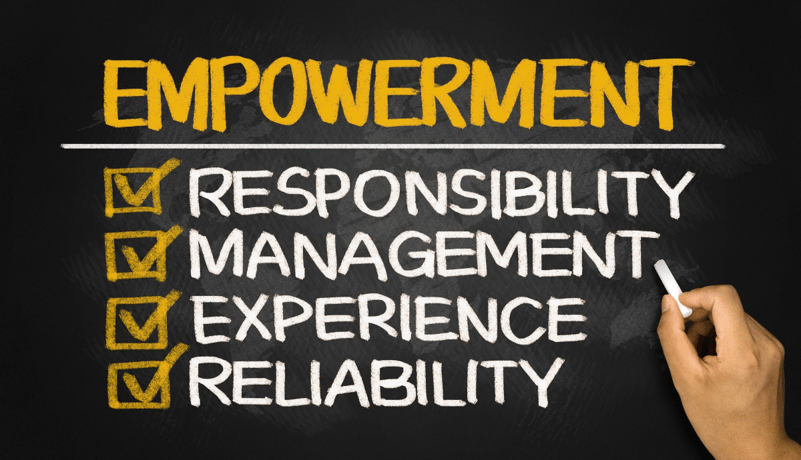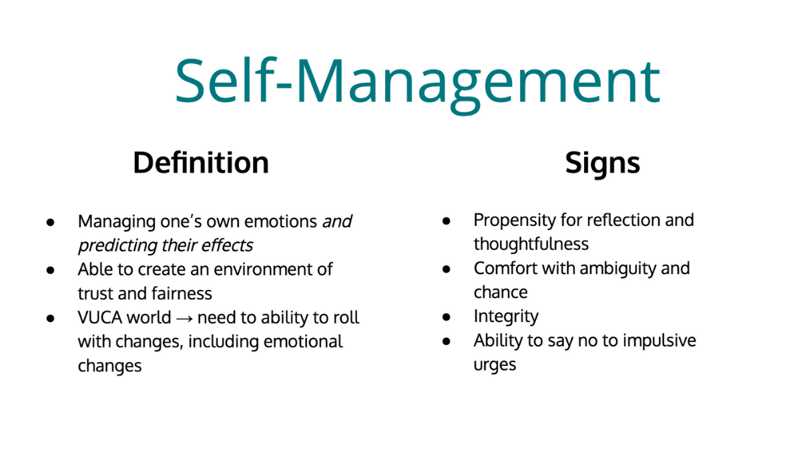An empowered team is a motivated team, and a motivated team gets results. But while team empowerment is one of the most compelling benefits of switching to Agile ways of working, actually empowering each individual member of the team is often easier said than done for many organizations. Why? Because most new Agile teams just haven’t cracked it yet.
When an Agile process and mindset are implemented holistically within the organization, empowerment of individual contributors and teams can be a major benefit of the methodology. As teams mature in their full-fledged application, empowerment is what pushes individuals to make decisions more autonomously, develop themselves as cross-functional individuals, and become self-managing.
Sadly, not all teams mature to the point of truly taking advantage of empowerment as a benefit of Agile. The most frequent obstacles that contribute to that include a lack of trust between leadership and employees, poor communication, low tolerance for failure, and setting unrealistic and unclear expectations.
As a result, most organizations focus on other benefits of Agile ways of working, like speed, without striving for the long-term benefits of deliberately empowering their teams.
As Agile coaches, we’ve seen both ends of this spectrum.
We’ve coached teams that revel in the lasting effects of team and individual empowerment. We’ve also seen plenty of teams and leaders who believe team empowerment as a benefit of Agile is just wishful thinking.
In this article, we explore what it truly takes for a team to achieve empowerment on the individual, team, and organizational levels.
Origins of Empowerment in Agile
Agile was born out of the need to change the inefficient ways of developing software products. Besides the work process itself, the treatment of people as “assets” or “resources” also had to change. For real teams to form within the Agile processes, collections of individual contributors would need serious attention.
Consequently, the idea of team empowerment in Agile has been a core components since its inception.
Initially, it appeared in the Agile Manifesto for software development back in 2001. The 17 creators understood that individuals didn’t actually need to be micromanaged to be productive. In fact, they did their best work when they were allowed more freedoms within the work process.
This best practice became in essential part of the Agile Manifesto. Its fifth principle states that Agile organizations should:
“Build projects around motivated individuals. Give them the environment and support they need, and trust them to get the job done."
When Agile became popular in marketing, this pillar persisted. In the summer of 2012, a group of marketers came together to formulate an Agile Marketing Manifesto.
Together, they came up with 7 Agile marketing values and 10 principles that elaborate on them. Team empowerment remained a central idea based on the positive effect it had on the software industry. The familiar principle was adapted to encourage marketers to:
“Build marketing programs around motivated individuals. Give them the environment and support they need, and trust them to get the job done.”
In addition, marketing team empowerment became a foundation for another principle of the manifesto:
“Don’t be afraid to fail; just don’t fail the same way twice”.
It aimed to create a safe environment for experimentation, in which teams could be creative. Empowerment is also a pillar of several of the Agile values. Its central aim is to decentralize the decision-making process by placing more emphasis on:
“Customer-focused collaboration over silos and hierarchy.”
The idea of team empowerment, and all its elements, is embedded in the core values and principles of Agile as a methodology. Yet, for many teams, even those whose processes are 100% Agile, the concept still seems out of reach.
Is Team Empowerment in Agile a Myth?
Team empowerment has deep roots as a core aspect of true agility. Yet, there are very common reasons why some teams still consider this benefit a myth.
They haven't truly embraced the Agile mindset
“Agile theater” is a common culprit that contributes to the belief that team empowerment in Agile is a myth. Organizations that practice Agile theater are those that use some Agile practices without really being Agile. This is a common phenomenon that happens in enterprises of any size.
Most frequently, an implementation of fake Agile is a result of a partial or varied understanding of what Agile actually is. This gap leads to a skewed implementation of its practices.
Instead of focusing on the Agile marketing values and principles, the team rallies behind the tools and practices associated with the methodology (e.g. Kanban boards, Sprints, etc.). Unfortunately, these tools will bring little to no improvement without the Agile mindset as a base.
Lack of support from leadership
Another frequent reason that turns team empowerment in Agile into a myth for many is the lack of support from upper management. In fact, it's one of the five top reasons why Agile transformations fail entirely.
To achieve true agility and marketing empowerment, you need to have buy-in from the people at the top of your organization.
If the company leaders don’t support an incentive to break down organizational silos, there's very little chance of them creating an environment in which empowerment can thrive. As a result, Agile principles and values start to break down in the face of real world situations.
Without leadership’s protection of the team’s Agile implementation, many teams will need to cut corners to complete their projects. Access to information will remain gated and inter-team collaboration will be difficult without the involvement of a manager.
Not owning the “how” of the team process
Micromanagement is the next big contributor to the belief that team empowerment in Agile is just a myth. For some managers, it ' easy to tell the everyone “You're empowered!” but not so easy to actually allow your team to make decisions about how they get work done.
Without giving some control to the team, managers risk compromising the whole Agile transformation and preventing their team from becoming high performing.
The team is the only Agile pocket in the organization
In some cases, being the only Agile team in your organization can be difficult because it perpetuates the feeling that even if you rock at Agile, the impact of the methodology will always be limited.
Negotiating with stakeholders becomes a constant battle, adjacent teams have little understanding of your ways of working, and empowerment is an option only within your core team.

Team Empowerment in Agile Is Possible
Yes, challenges exist, but team empowerment is possible. We’ve seen high performing Agile teams, in all functions, who are empowered to self-manage to the point of high performance.
We’ve discovered that the most important factor in realizing team and individual empowerment is shared understanding among teams and leaders.
All empowered Agile teams have two key characteristics in common:
- They understand the true fundamentals of the Agile mindset, beyond its practices.
- They have the support to make use of that mindset for maximum impact.
More specifically, teams on the execution level can align around strategic goals, maintain process ownership, and follow team best practices. Let's dig deeper into those three components.
Alignment around common goals
Effective communication is vital for any organization, and that's even more true when we want individuals to be empowered decision makers. If leaders aren't confident that the team sees the bigger picture, they can’t reasonably expect them to make the right decisions at the right time.
The execution teams, likewise, must understand how their actions contribute to the strategic success of the organization.
With this aim, it's not uncommon for empowered Agile organizations to practice big room planning. This quarterly meeting gathers stakeholders from different departments that depend on each other to plan ahead. Afterwards all the attendees have an action plan for the coming quarter of work.
Even more important, the plan and its interconnections get communicated to all involved teams.
During big room planning, the teams and stakeholders develop a shared understanding of how individual campaigns and projects affect the business, as well as other teams. Everyone then has a better chance at contributing to those goals.
In addition, a growing number of organizations are starting to apply Portfolio Kanban systems, or at least the visualization and connectivity associated with them. In its essence, Portfolio Kanban is a method for applying the Kanban method at scale.
It relies on multiple levels of visual management boards connected across the organizational hierarchy to achieve complete process transparency. With Portfolio Kanban, organizations can visualize and connect every aspect of their work from strategic level initiatives down to the individual tasks that need to be processed on the team level for completing them.
This system relies on card connections like parent and child to tie everything together and ensures that everyone involved in processing them understands how their efforts contribute to the well-being of the organization.
Employee process ownership
Even if they have little influence over WHAT work they need to do, teams should be able to control HOW they do it.
Ownership of the "how" allows even individual contributors to feel in control of the work process. Further, it allows them to take pride in their contribution to achieving the company’s goals.
When individual contributors get the opportunity to influence how they process their work, great things happen. For example, contributors feel invested in building out a streamlined and efficient process for their teams. They constantly try to perfect it by removing the obstacles that prevent them from delivering value.
Tthey aren't afraid to experiment and look for better ways to boost the performance of the team.
Having an Agile team charter
The Agile team charter is a shared document that serves as a set of rules generated by the team, for the team. It's a common recipe that the team agrees upon and follows to successfully deliver value to the organization.
By establishing a team charter, teams can define what empowerment means in practice. These rules can't be "dropped" onto the team by a manager or team lead. Instead, they should be suggestions that the members of the group themselves accept.
Keep team charters simple and concise; start by including approximately 7-10 rules per team, and make sure to include the consequences of deviating from the team's agreement.
Empowering Agile Teams
Facilitating the environment for teams to flourish requires deliberate action and patience from leaders. Being a leader in an Agile context means that one of your key roles within the organization is to empower teams to high performance by:
Allowing teams to self-manage
A self-organizing team is an empowered team. When the manager steps down from the traditional pedestal of a boss and takes the role of a servant leader, the dynamic changes for the better.
The manager’s function needs to transition from a sole decision-maker to a facilitator and advisor to the team. This allows team members to evolve into process owners who participate actively in the planning process and retrospective meetings.
For example, instead of just giving instructions, leaders who want to facilitate empowerment should encourage their team members to seek solutions when problems arise or new projects are planned. They should advise and challenge their subordinates but stick to a positive connotation and be as encouraging as possible.
In time, team members will start to proactively engage colleagues from other departments to maximize the value they produce and improve the efficiency of their work.
Encouraging continuous process improvement
It doesn't matter whether you’re practicing Scrum, Kanban, or a hybrid Agile approach. In both cases, it’s crucial to frequently evaluate the results of your work and discuss both the positive and negative aspects of the process. Encourage your teams to question the status quo, share their observations, and suggest novel ways of improving the current standard.
Facilitate frequent retrospective meetings during which everybody feels safe to make mistakes for the sake of improving. A good way to create a safe environment is to look at process improvement suggestions as experiments.
An experiment must have a clear hypothesis, quantitative success metrics and a time frame. The Plan-Do-Check-Act cycle (PDCA) is an ideal way to manage the experimental process in marketing.
Focus on transparency
An accessible, transparent process can do wonders for motivating individuals to take ownership of their work.
It helps individuals stay accountable throughout the course of a project. By keeping both tasks and experiments visible using a tool such as a Kanban board, leaders are passively facilitating an environment of openness and communication.
Most importantly, this can boost team trust and highlight process problems early enough for the team to act quickly.
Acknowledging acts of leadership
Facilitating empowerment requires consistent action and patience. Mature teams that are used to more traditional ways of working and strictly following instructions may have a difficult time embracing empowerment at first.
Therefore, to support the process, the leader needs to be proactive in acknowledging acts of leadership and process ownership within their team. Whether it’s a public praise on a Slack channel or in front of everyone attending a meeting, encouragement plays a key role in facilitating empowerment within the team.
Explore all the facets of Agile leadership
Empowerment is a crucial part of any successful Agile transformation. With the right attitude and consistent action, it can become the everyday reality for any marketing team.
However, without the proper incentive from the organization’s leadership, empowerment may never become anything more than wishful thinking.
Overall, being an effective Agile leader might mean changing the way you treat your team. Finding creative ways to "serve the team" is the main focus of any great Agile leader.
This includes clearing their path from obstacles, negotiating with other teams on their behalf, and making sure they have the information they need to do their best work.
Discover more ways to empower your teams by taking one of our open, online certification courses for leaders!






